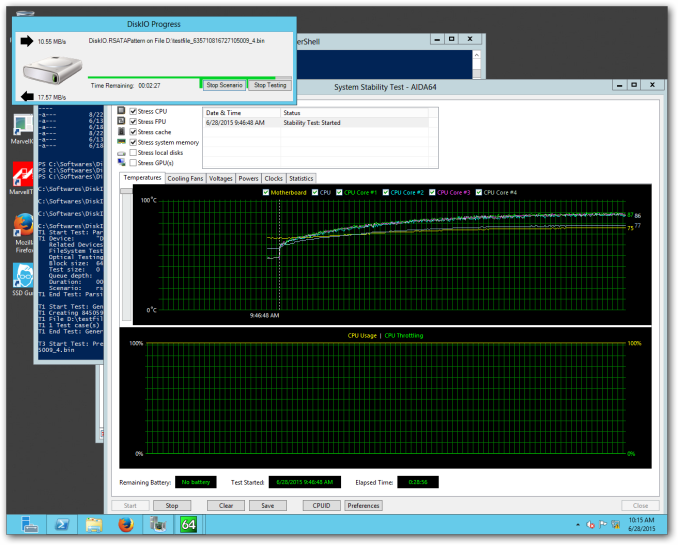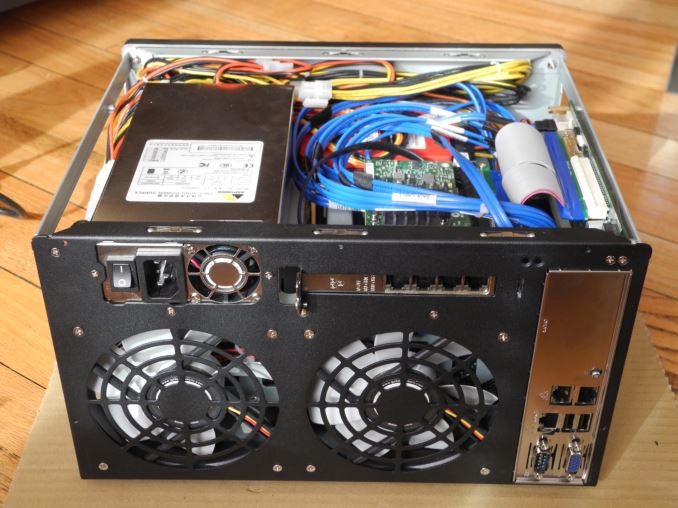ASRock Rack C2750D4I and U-NAS NSC-800: A DIY File Server
by Ganesh T S on August 10, 2015 8:45 AM EST- Posted in
- NAS
- storage server
- Avoton
- ASRock Rack
- U-NAS
Miscellaneous Aspects and Concluding Remarks
Low power consumption and the ability to keep the drives cool under stress are some of the desirable characteristics of file servers. In order to evaluate this aspect, we subject the system with Windows Storage Server 2012 R2 to a stability test using AIDA64. For stressing the disks (storage spaces volume using the drive bays), we used Microsoft's DiskIO with the pre-defined worst-case SATA patterns issued randomly with verification.
We find that the CPU doesn't throttle and the cores stabilize around 87 C, with the motherboard at 75 C. During this process, we also recorded power consumption at the wall. We found that the maximum power consumption was around 70 W, while the idling power consumption was around 38 W.
The ASRock Rack C2750D4I with the U-NAS NSC-800 is the first of three file servers that we have evaluated with Ubuntu 14.04 and Windows Storage Server 2012 R2. While the Phoronix Test Suite benchmarks have been chosen for their relevant to file server workloads, it appears that the SPEC SFS 2014 benchmarks do not bring out what people use the Storage Spaces feature for. We are still optimizing the testbed for SPEC SFS 2014, and we do have plans to evaluate other NAS OSes used in DIY builds using the same approach.
Coming to the business end of the review, we have two things to discuss. The ASRock Rack C2750D4I is almost the ideal motherboard for power users wanting to build a dedicated low-power file server or NAS. Native USB 3.0 support would have been nice, but a add-on card solution is not a bad one for those desiring high-speed external I/O. Other than that, there is not much to complain - The layout of the motherboard's SATA ports ensure that most of the disks can talk at full speed to the Avoton SoC. This becomes an issue only if one decides to take maximum advantage by utilizing all the SATA ports on the board. However, in our evaluation scenario, as the platform for a 8-bay file server, it fit in perfectly.
This brings us to the second aspect - the 8-bay U-NAS NSC-800. There are plenty of storage-focused chassis designs to choose from. In fact, the Silverstone DS380 is an excellent choice for those looking to install the motherboard in a flexible system. On the other hand, the NSC-800 brings in the compactness factor into the equation. Simply put, it is not possible to get a 8-bay NAS chassis smaller than the NSC-800. Any smaller, and a mini-ITX board with a single-slot PCIe card is not going to fit in. Even though U-NAS tries its best to make cabling easier by providing the SATA cables in a bundle from the backplane, installing the motherboard in such a cramped space is definitely a challenge.
The build presented in this review has a diskless cost of around USD 845 - a completely reasonable number given that the unit contains 8GB of ECC RAM. A look at the prices of commercial off-the-shelf diskless file servers based on Avoton make the DIY approach very attractive.












48 Comments
View All Comments
nevenstien - Monday, August 10, 2015 - link
An excellent article on a cost effective File Server/NAS DIY build with a good choice of hardware. After struggling with the dedicated NAS vs. File server question for over a year I decided on FreeNAS using jails for whatever service I wanted to run. I was not a FreeNAS fan before the latest versions which I found very opaque and confused. My experience in the past with how painful hardware failures can be on storage systems even at a PC level convinced me the ZFS file system is the file system of choice for storage systems. The portability of the file system trumps everything else in my opinion. Whether you install FreeNAS or ZFS based Linux the ZFS file system should be the one that is used. When a disk fails its easy and when the hardware fails it’s just a matter of moving the disks to hardware that is not vendor dependent which means basically any hardware with enough storage ports. The software packages of the commercial NAS vendors is great but the main priority for me is the data integrity, reliability portability than the other services like serving video, web hosting or personal cloud services.tchief - Monday, August 10, 2015 - link
Synology uses mdadm for their arrays along with ext4 for the filesystem. It's quite simple to move the drives to any hardware that runs linux and remount and recover the array.ZeDestructor - Monday, August 10, 2015 - link
If you virtualize, even the "hardware" becomes portable :)xicaque - Monday, November 23, 2015 - link
are you pretty good with Freenas? I am not a programmer and there are things that the freenas manual does not address in a clearer way to me. I have a few questions that I like to ask offline. Thanks.thewishy - Tuesday, December 1, 2015 - link
Agreed, after data corrupting following a disk failure on my synology, it's either a FS with checksum or go home.Based on those requirements, it's ZFS or BRTFS. ZFS disk expansion isn't ideal, but I can live with it. BRTFS is "getting there" for RAID5/6, but it's not there yet.
The choice of board for the cost comparison is about 2.5x the price of the CPU (Skylake pentium) and Motherboard (B150) I decided on. Add a PCI-E SATA card and life is good.
Granted, it doesn't support ECC, but nor do a lot of mid-range COTS NAS units.
Navvie - Monday, August 10, 2015 - link
Any NAS or Fileserver which isn't using ZFS is a non-starter for me. Likewise a review of such a system which doesn't include some ZFS numbers is of little value.I appreciate ZFS is 'new' but people not using it are missing a trick and AnandTech not covering it are doing a disservice to their readers.
All IMO of course.
tchief - Monday, August 10, 2015 - link
Until you can expand a vdev without having to double the drive count, ZFS is a non starter for many NAS appliance users.extide - Monday, August 10, 2015 - link
You can ... you can add drives one at a time if you really want (although I wouldn't suggest doing that...)jb510 - Monday, August 10, 2015 - link
Or one could use BtrFS. Which could stand for better pool resizing (it doesn't, that's just a joke people).Check out RockStor, it's no where near as mature as FreeNAS but it's catching up fast. Personally I'd much rather deal with Limux and docker containers than BSD and jails.
DanNeely - Monday, August 10, 2015 - link
If there're major gotchas involved it's a major regression compared to other alternatives out there.I'm currently running WHS2011 + StableBit DrivePool. I initially setup with 2x 3GB drives in mirrored storage (raid 1ish equivalent). About a month ago, my array was almost completely full. Not wanting to spend more than I had to at this point (I intend to have a replacement running by December so I can run in parallel for a few months before WHS is EOL) I slapped in an old 1.5GB drive into the server. After adding to the array and rebalancing it I had an extra 750GB of mirrored storage available; it's not a ton but should be plenty to keep the server going until I stand it down. I don't want to lose that level of flexibility in being able to add un-matched drives into my array at need with whatever I use to replace my current setup with.
If the gotcha is that by adding a single drive I end up with an array that's effectively a 2 drive not-raid1 not-raid0ed with a single drive, it'd be a larger regression in a feature I know I've needed than I'm confortable just to gain a bunch of improvements for what amount to what-if scenarios I've never encountered yet.